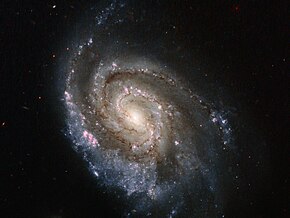| NGC 6984 | |
|---|---|
 NGC 6984 imaged by the Hubble Space Telescope | |
| Observation data (J2000 epoch) | |
| Constellation | Indus |
| Right ascension | 20h 57m 53.987s[1] |
| Declination | −51° 52′ 15.13″[1] |
| Redshift | 0.015386[1] |
| Heliocentric radial velocity | 4577 km/s[1] |
| Distance | 180 million ly[2] |
| Apparent magnitude (V) | 12.65[1] |
| Apparent magnitude (B) | 13.19[1] |
| Surface brightness | 22.82 mag/arcsec2[3] |
| magnitude (J) | 10.94[3] |
| magnitude (H) | 10.25[3] |
| magnitude (K) | 9.99[3] |
| Characteristics | |
| Type | Spiral (SAc)[3] |
| Apparent size (V) | 1.403 x 1.038 arcmin[1] |
| Other designations | |
| IRAS 20543-5203, 2MASX J20575398-5152151, PGC 65798, AM 2054-520, APMBGC 235+046+104, ISOSS J20578-5152, SGC 205419-5203.8, ESO 235- G 020 | |
NGC 6984 is a barred spiral galaxy located 180 million light years away in the constellation Indus. It is a Type II Seyfert galaxy, a type of Active galactic nucleus (AGN).[4] It is situated south of the celestial equator, and is visible with the help of a telescope having an aperture of 10 inches (250 mm) or more.[3] It was discovered on 8 July 1834 by British astronomer John Herschel.[5]
- ^ a b c d e f g "Search Results for NGC 6984". Astronomical Database. SIMBAD. Retrieved 5 November 2013.
- ^ "Stellar explosions in NGC 6984". ESA/Hubble Picture of the Week. Retrieved 5 November 2013.
- ^ a b c d e f "NGC 6984 - Spiral Galaxy in Indus". thesky.com. The Sky LIVE. Retrieved 12 Sep 2024.
- ^ "NGC 6984". simbad.u-strasbg.fr. Retrieved 12 Sep 2024.
- ^ Seligman, Courtney. "NGC 6984". Celestial Atlas. Retrieved 22 August 2024.